If you are over the age of 40, you probably have some age-related knee changes. These changes are just as common and normal as gray hair and wrinkles. But often the phrasing has a negative connotation. Do you know what age-related knee changes are most often called? Degenerative Joint Disease.
These age-related changes are NORMAL and are not/should not be termed a disease. If it is a disease then so is that gray hair and wrinkles…which everyone just considers normal aging…though most would like not to deal with. So why then are these knee changes termed disease? That is a great question.
The answer is the medical community is great at selling disease/disability and the need for medical care. They would prefer people be addicted to the “medical system”. It helps them to be more profitable than selling an actual solution to the problem.
What solution you ask?
Taking a proactive approach for the health and wellbeing of our body. Dentists got it right selling the need for people to visit them two times a year for preventive services. But this is not done with muscle and joint health. BUT it absolutely should be. If people knew how much better they could feel and function IF they took proactive steps in their 40s, they would be amazed.
What proactive steps are you referring to?
Working on physical fitness of course. This does not mean running, pushups, and sit-ups…though it could. What I am alluding to is participating in some form of cardiovascular exercise (swim, walk, cycle, etc). Additionally learning to perform a series of exercises designed to maximize lower body strength and flexibility. This does not mean you must work out at a gym. Many exercises can be performed from the comfort of your own home, on your time.
But what if you already have some ache or pain in the knee?
No worries, there are muscle and joint experts out there to solve those issues. They will evaluated your function and develop a plan to address key elements. In most cases people will be able to function better and live with less or no pain. Don’t have pains but are concerned due to family members who have/had issues? Then take the proactive approach and get an pre-emptive assessment. Learn the areas where you can improve so that you are less likely to develop issues later.
Not sure where to begin?
Click the following Link to connect with a muscle and joint expert today.
